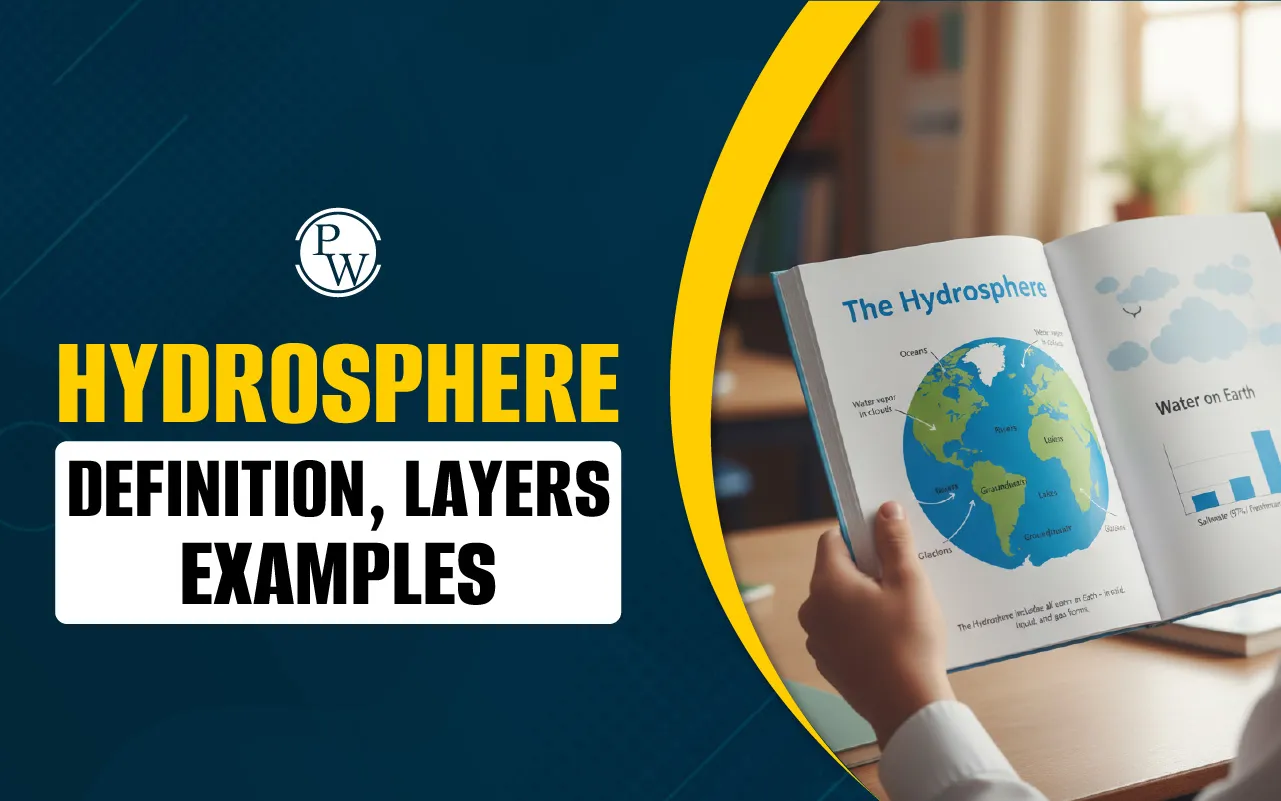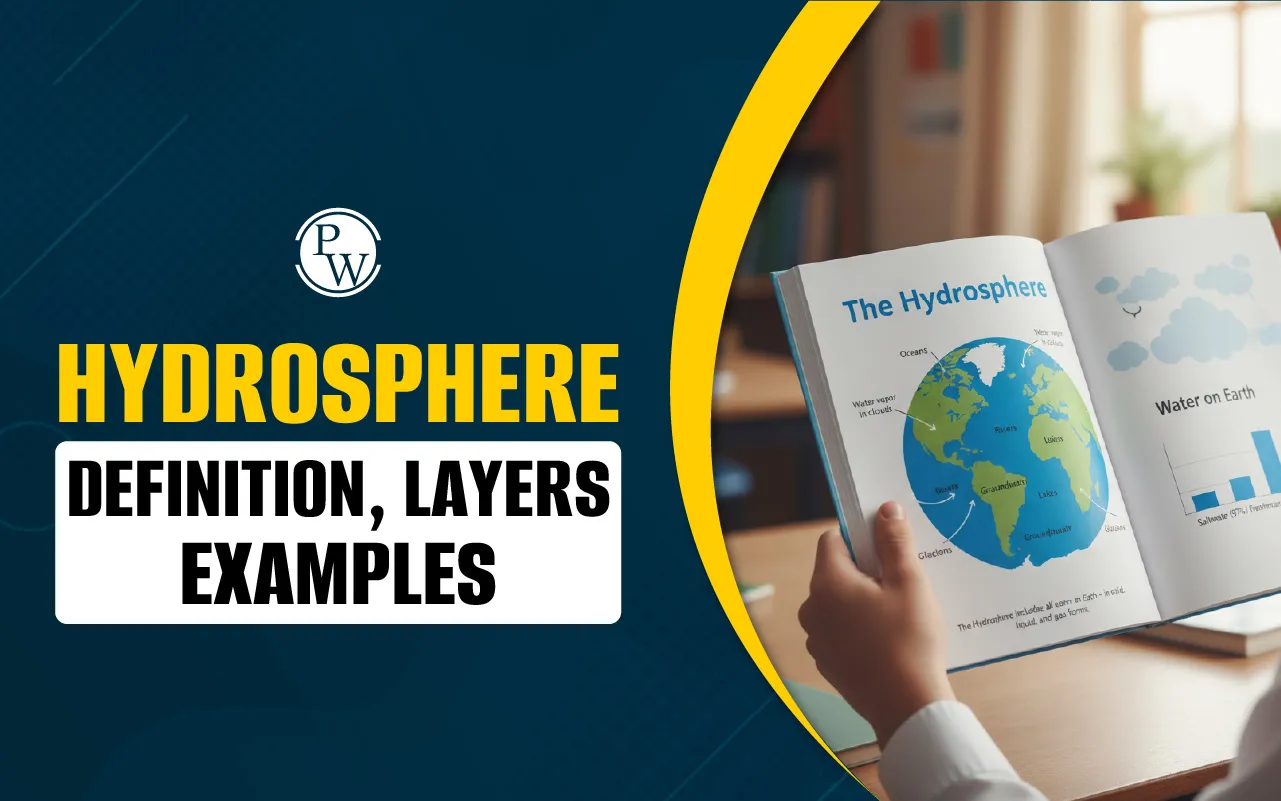

What is Hydrosphere?
The hydrosphere is all the water found on, under, and above the surface of the Earth. It includes oceans, seas, rivers, lakes, ponds, glaciers, underground water, and even the tiny droplets of water in the air like clouds and mist.
Yes, even the ice in the North and South Poles, the fog in the air, and the moisture in the soil are part of the hydrosphere!
So, the next time it rains or you see snow, you are seeing a piece of the hydrosphere in action.
Read More: Properties of Water
Parts of the Hydrosphere
The hydrosphere is made up of different types of water. Here are some hydrosphere examples:
-
Oceans and Seas – These are the biggest parts of the hydrosphere. Oceans cover over 70% of the Earth's surface.
-
Rivers and Lakes – These are fresh water sources. We use them for drinking, farming, and fun activities.
-
Glaciers and Ice Caps – These are frozen parts of water, found in very cold places like Antarctica.
-
Groundwater – This is water found underground, in wells and aquifers.
-
Atmospheric Water – This includes water vapor, clouds, and rain in the air.
Each of these examples helps us understand what makes up the hydrosphere and where we can find water on Earth.
Hydrological Cycle
Now that we know what the hydrosphere is, let’s learn about how water moves through it. This movement of water is called the hydrological cycle or the water cycle.
Here is how the hydrological cycle works:
-
Evaporation – The sun heats water in oceans, lakes, and rivers. It turns into vapor and rises into the air.
-
Condensation – Water vapor cools down and forms clouds in the sky.
-
Precipitation – When clouds become heavy, water falls back to the Earth as rain, snow, sleet, or hail.
-
Collection – The water gathers in rivers, lakes, oceans, and underground.
-
The cycle starts again!
This never-ending hydrological cycle is very important for life. It keeps water moving around the planet and helps plants grow, fills lakes and rivers, and even brings us rain to drink.
Read More: Climate of India
Importance of Hydrosphere
The importance of hydrosphere cannot be explained in just one sentence. It helps life on Earth in many ways. Let’s look at why the hydrosphere is so important:
-
The hydrosphere supports all living things. Every human, animal, and plant depends on water to stay alive. The hydrosphere gives us clean water to drink, helps crops grow in farms, and keeps animals healthy. Without it, life on Earth could not survive.
-
It helps control Earth’s climate. The water in oceans and the air works together with the atmosphere to balance temperatures. This helps prevent the Earth from becoming too hot or too cold. It also brings rainfall, which is important for farming, forests, and drinking water.
-
The hydrosphere provides food. Many kinds of food come from water, such as fish, crabs, and seaweed. These are found in oceans, rivers, and lakes. Without the water in the hydrosphere, we would not have access to these important sources of food.
-
It is used for transportation and fun. People use ships and boats to move goods across oceans and rivers. Waterways make travel possible in many parts of the world. Also, people enjoy swimming, fishing, and boating in lakes, seas, and rivers. These fun activities are all part of life with the hydrosphere.
-
The hydrosphere is a source of energy. Moving water from rivers and dams is used to produce electricity. This is called hydropower. It is a clean and renewable way to make energy, which means it does not pollute the environment and can be used again and again.
These examples show that the hydrosphere is very important for life, nature, and our everyday activities. It plays a big role in keeping Earth safe, healthy, and full of life.
Read More: Rainwater Harvesting
Hydrosphere Examples in Daily Life
Now let’s look at some hydrosphere examples that you can see or use every day:
-
Taking a shower – The water in your tap comes from rivers or underground wells.
-
Watching clouds – Water vapor forms the clouds you see in the sky.
-
Playing in the snow – Snow is frozen water from the hydrosphere.
-
Boating on a lake – Lakes are fresh water bodies, part of the hydrosphere.
-
Swimming in the ocean – Oceans are the largest parts of the hydrosphere.
These everyday hydrosphere examples help us see how close water is to our lives.
Fun Facts About the Hydrosphere
-
About 97 percent of the Earth’s water is in the oceans. Only about 3 percent is fresh water.
-
Almost 69 percent of the fresh water is frozen in glaciers and ice caps.
-
The same amount of water exists on Earth today as it did millions of years ago. The hydrosphere keeps recycling it through the hydrological cycle.
-
Water in the atmosphere can form clouds, fog, and dew. These are all small but important parts of the hydrosphere.
-
Earth is not the only place with a hydrosphere. Some scientists believe that Jupiter’s moon Europa has a frozen hydrosphere under its surface.
Read More: Soil - Definition, Composition & Classification
Threats to the Hydrosphere
The hydrosphere is very important, but it is also in danger. These are some of the things that can harm it:
-
Water Pollution: Pollution happens when factories or homes dump waste into rivers, lakes, or oceans. This makes the water dirty and unsafe for people, animals, and plants.
-
Climate Change: Climate change causes Earth’s temperature to rise. Warmer temperatures can melt glaciers and ice caps, which may lead to floods or long dry periods called droughts.
-
Water Overuse: Using too much water in farming, homes, or cities can lower water levels in rivers and lakes. This may lead to water shortages and harm the environment.
-
Oil Spills: Oil spills in oceans and seas can harm fish, birds, and other sea life. They also make the water dangerous and dirty for people and wildlife.
We must take care of the hydrosphere to protect clean water, support life, and keep our planet safe for future generations.
How Students Can Help Protect the Hydrosphere?
Even if you are young, there are simple ways you can help take care of the hydrosphere. Here are a few easy actions you can start today:
-
Turn Off: Always turn off taps when you are not using them, like when brushing your teeth. This helps save water.
-
Reuse Water: Don’t waste water. You can use leftover water from a bottle to water plants instead of throwing it away.
-
Avoid Littering: Never throw trash on the ground. Litter can be washed into rivers and oceans, polluting the water and harming animals.
-
Spread Awareness: Talk to your family and friends about why saving water is important. The more people know, the more we can protect the hydrosphere together.
Saving the hydrosphere begins with small, everyday choices. Every drop you save helps protect life on Earth.
Also read: Transpiration in Plants
Interactive Online Classes Tailored for Every Child
Is your child finding it difficult to keep up in school? Many students struggle when lessons move too quickly, leaving doubts unresolved. PW CuriousJr School Tuition Program makes learning easier through engaging online after-school classes for Grades 3 to 8. Our program covers Maths, Science, English, and Social Studies, aligned with school curriculums and each child’s learning pace.
What makes our classes stand out:
-
Two teachers in every class for teaching and instant doubt-solving
-
Personalised attention and homework assistance for every student
-
Interactive lessons with visuals and fun learning activities
-
Regular parent updates on student progress and performance
Children learn in a supportive, engaging environment that boosts confidence and strengthens understanding across subjects. Book a six-day demo class for just ₹29 today!
Hydrosphere FAQs
What is hydrosphere in short?
Why is the hydrosphere important?
What are some examples of the hydrosphere?
What is the hydrological cycle?













